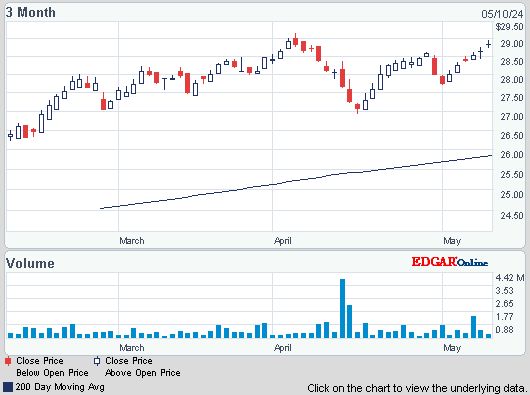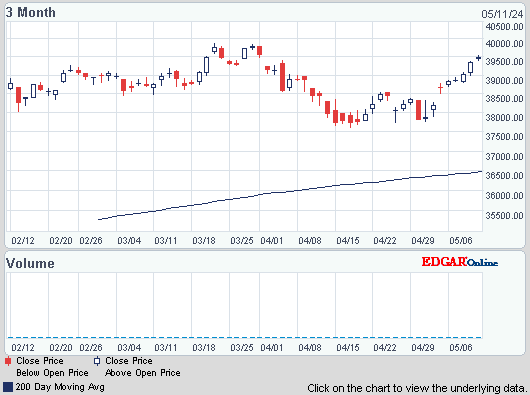Dow rose 108, advancers over decliners better than 6-1 & NAZ gained 31. The Financial Index added 2+ to 195, its highest level in more than a month.
The MLP index shot up 4+ to the 366s & the REIT index was up 1+ to the 256s. Junk bond funds rose but Treasuries fell, bringing higher yields. Oil advanced as Spanish bond yields declined after the gov met its target at a bill auction & European creditors prepared to ease Greece’s bailout terms. Gold continues in sideways trading.


Photo: Bloomberg
Builders broke ground on more single-family houses for a 3rd consecutive month in May & rising construction permits pointed to further gains. Work began on 516K one-family houses last month, up 3.2% from Apr & the most this year, according to the Commerce Dept. However, a slump in construction of apartments, which can be volatile, led to an unexpected drop in total housing starts. Building permits, a proxy for future construction, climbed to the highest level since Sep 2008, showing the combination of lower prices & record-low mortgage rates is stimulating demand & encouraging new projects. Total starts dropped 4.8% to 708K in May from a revised 744K in the prior month (the highest since Oct 2008). The forecast was for 722K. Building permits increased 7.9% to 780K, reflecting gains in single-family & multifamily homes.
Housing Starts in U.S. Fall 4.8% in May on Apartments

Photo: Bloomberg
Walgreen, a Dividend Aristocrat, will pay $6.7B for 45% of the UK’s Alloiance Boots to create a global chain of pharmacies. This will be paid with $4B in cash & the remainder in stock, with an option to gain full control in about 3 years. The stake is being acquired from a group led by KKR & Alliance Boots Chairman Stefano Pessina, who bought the company in a £12.1B ($19B) buyout 5 years ago. The combination gives WAG the UK.’s largest drugstore-chain company, with more than 11K stores in 12 countries & 370 distribution centers. WAG will be able expand into emerging markets as well. WAG has an option to buy the remaining 55% in 3 years. The stock dropped 1.86 (6%) on the news.
Walgreen to Buy 45% Stake in Boots for $6.7 Billion

In Apr, employers posted the fewest job openings in 5 months, suggesting hiring will remain sluggish in the months ahead. The Labor Dept said that job openings fell to a 3.4M, down from 3.7M in Mar (the highest in nearly 4 years). The decline could mean employers are growing more cautious about adding workers in the face of financial turmoil in Europe & slower growth in the US. Job openings can take 1-3 months to fill. There were 12.5M unemployed in Apr. That means there was an average of 3.7 people competing for each open job. In a healthy job market, the ratio is usually around 2 to 1. Openings have risen by almost a 1/3 since the recession ended in Jun 2009, but they are still below pre-recession levels of 5M per month. The decline in openings has coincided with a sharp slowdown in hiring. Employers added an average of only 73K jobs in Apr & May, down from a monthly average of 226K in Q1. Fewer people quit their jobs last month, a pessimistic sign because more quits are evidence that workers are confident that they can find new jobs elsewhere.
US employers post fewest job openings in 5 months AP
Buyers are back, bidding up stock prices. The housing data is encouraging, but the industry is still a long way form a robust recovery. The € is up to $1.27, 3¢ above its recent lows, on word that the money guys will grade easy, helping troubled countries muddle by. The markets may also be hoping for a QE3 out of the FOMC meeting. I don't think so, but nobody knows. The decision on Obamacare from the Supreme Court should come any day & that can be a market mover. Dow is up 750 off its lows last month.

The MLP index shot up 4+ to the 366s & the REIT index was up 1+ to the 256s. Junk bond funds rose but Treasuries fell, bringing higher yields. Oil advanced as Spanish bond yields declined after the gov met its target at a bill auction & European creditors prepared to ease Greece’s bailout terms. Gold continues in sideways trading.
MLP (Alerian MLP index tracking fund)
Treasury yields:
U.S. 3-month | 0.081% | |
U.S. 2-year | 0.282% | |
U.S. 10-year | 1.613% |
| CLN12.NYM | ....Crude Oil Jul 12 | ...84.23 | ... |
| GCM12.CMX | ...Gold Jun 12 | ....1,622.80 | ... | (0.2%) |
Get the latest daily market update below:

Builders broke ground on more single-family houses for a 3rd consecutive month in May & rising construction permits pointed to further gains. Work began on 516K one-family houses last month, up 3.2% from Apr & the most this year, according to the Commerce Dept. However, a slump in construction of apartments, which can be volatile, led to an unexpected drop in total housing starts. Building permits, a proxy for future construction, climbed to the highest level since Sep 2008, showing the combination of lower prices & record-low mortgage rates is stimulating demand & encouraging new projects. Total starts dropped 4.8% to 708K in May from a revised 744K in the prior month (the highest since Oct 2008). The forecast was for 722K. Building permits increased 7.9% to 780K, reflecting gains in single-family & multifamily homes.
Housing Starts in U.S. Fall 4.8% in May on Apartments

Walgreen, a Dividend Aristocrat, will pay $6.7B for 45% of the UK’s Alloiance Boots to create a global chain of pharmacies. This will be paid with $4B in cash & the remainder in stock, with an option to gain full control in about 3 years. The stake is being acquired from a group led by KKR & Alliance Boots Chairman Stefano Pessina, who bought the company in a £12.1B ($19B) buyout 5 years ago. The combination gives WAG the UK.’s largest drugstore-chain company, with more than 11K stores in 12 countries & 370 distribution centers. WAG will be able expand into emerging markets as well. WAG has an option to buy the remaining 55% in 3 years. The stock dropped 1.86 (6%) on the news.
Walgreen to Buy 45% Stake in Boots for $6.7 Billion
Walgreen (WAG)
In Apr, employers posted the fewest job openings in 5 months, suggesting hiring will remain sluggish in the months ahead. The Labor Dept said that job openings fell to a 3.4M, down from 3.7M in Mar (the highest in nearly 4 years). The decline could mean employers are growing more cautious about adding workers in the face of financial turmoil in Europe & slower growth in the US. Job openings can take 1-3 months to fill. There were 12.5M unemployed in Apr. That means there was an average of 3.7 people competing for each open job. In a healthy job market, the ratio is usually around 2 to 1. Openings have risen by almost a 1/3 since the recession ended in Jun 2009, but they are still below pre-recession levels of 5M per month. The decline in openings has coincided with a sharp slowdown in hiring. Employers added an average of only 73K jobs in Apr & May, down from a monthly average of 226K in Q1. Fewer people quit their jobs last month, a pessimistic sign because more quits are evidence that workers are confident that they can find new jobs elsewhere.
US employers post fewest job openings in 5 months AP
Buyers are back, bidding up stock prices. The housing data is encouraging, but the industry is still a long way form a robust recovery. The € is up to $1.27, 3¢ above its recent lows, on word that the money guys will grade easy, helping troubled countries muddle by. The markets may also be hoping for a QE3 out of the FOMC meeting. I don't think so, but nobody knows. The decision on Obamacare from the Supreme Court should come any day & that can be a market mover. Dow is up 750 off its lows last month.
Dow Jones Industrials:
Get your favorite symbols' Trend Analysis TODAY!


No comments:
Post a Comment